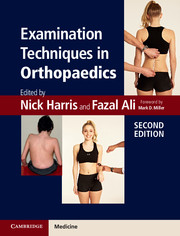Book contents
- Frontmatter
- Dedication
- Contents
- List of contributors
- Foreword
- Preface
- Acknowledgements
- 1 General principles of orthopaedic clinical examination
- 2 Examination of the shoulder
- 3 Examination of the elbow
- 4 Examination of the wrist
- 5 Examination of the hand
- 6 Examination of the peripheral nerves in the hand and upper limb
- 7 Examination of the adult spine
- 8 Examination of the hip
- 9 Examination of the knee
- 10 Examination of the foot and ankle
- 11 Examination of the brachial plexus
- 12 Orthopaedic examination techniques in children
- 13 Examination of the spine in childhood
- Index
- References
12 - Orthopaedic examination techniques in children
- Frontmatter
- Dedication
- Contents
- List of contributors
- Foreword
- Preface
- Acknowledgements
- 1 General principles of orthopaedic clinical examination
- 2 Examination of the shoulder
- 3 Examination of the elbow
- 4 Examination of the wrist
- 5 Examination of the hand
- 6 Examination of the peripheral nerves in the hand and upper limb
- 7 Examination of the adult spine
- 8 Examination of the hip
- 9 Examination of the knee
- 10 Examination of the foot and ankle
- 11 Examination of the brachial plexus
- 12 Orthopaedic examination techniques in children
- 13 Examination of the spine in childhood
- Index
- References
Summary
Paediatric orthopaedic examination is an art, and the success of the consultation relies on the surgeon’s ability to communicate with the parents and the child. Most children who are referred do not require surgery, and time is spent on reassuring the anxious parents or guardian of the normal variations in the development of the child. Quite often, observing the child during the consultation with the parents and a thorough general examination give the clues in making a clinical diagnosis.
The paediatric consulting area should be child-friendly, with toys and ample space for the child to play and for the surgeon to observe. Gaining the confidence of the child is crucial, as well as being warm and patient with the parents who are anxious and concerned. The initial interview should include introductions, as it is important to know the accompanying adults apart from the parents. They could be carers, guardians, grandparents or physiotherapists, and valuable information could be gained. History should be gained from the parents as well as the child, for, not infrequently, it could be conflicting. Clinical history skilfully obtained is the key to diagnosis, and a methodical examination of the child depending on the symptoms and age confirms your initial impression.
- Type
- Chapter
- Information
- Examination Techniques in Orthopaedics , pp. 171 - 189Publisher: Cambridge University PressPrint publication year: 2014
References
- 1
- Cited by

